Illutstration by Jennifer Tapias Derch
Consumers are already shopping through social media—around30% of internet usersin the US, to be precise. If you’re not already giving them an option to do so with your online store, you might be missing out.
Social commerce is the strategy of marketing and selling your products through social media platforms. Sales through social media channels worldwide is expected to nearlytriple by 2025—it’s an opportunity that’s too good to miss.
With so much you need to do to make and keep your ecommerce business successful, social commerce may be the last thing on your list. That’s why in this guide, we go over what you need to know aboutsocial commerce platformsand features that make social commerce possible, plus a list of companies that have already mastered social commerce that you can learn from and get inspired by.
Table of Contents
- What is social commerce?
- What features make up social commerce?
- How social media platforms enable social commerce
- 10 social commerce examples to inspire your creativity and strategy
- How Shopify can power up your social commerce
What is social commerce?
Social commerce is the process of selling your products using your social media profiles. You can use platforms like Instagram, Facebook, Pinterest, and TikTok to do so—each of them offers a unique set of features to put your products in front of potential customers during their social media scroll.
Video, influencer marketing, and live shopping are the biggest strategies andtrendsshaping the social commerce sphere.
Social commerce makes it easy for people to buy at the moment they’re most interested in your product.It’s changing the way we buybecause it removes the friction of leaving the social media app to search for the brand or product on Google. It gives customers everything they need to know and do to make a purchase inside the app.
Some platforms and locations even let merchants offer in-app checkout, meaning the customers can complete their order in the social media app instead of on the merchant’s website.
What features make up social commerce?
Brands can leverage social commerce in many different ways. Here are the key features and functionalities that make buying through social media possible and easy.
Storefronts on social profiles
Platforms like Instagram and Facebook let you create a rich social media storefront. In many ways, these storefronts can reflect the structure of your ecommerce website, with collections, product pages with detailed descriptions, and recommended products.
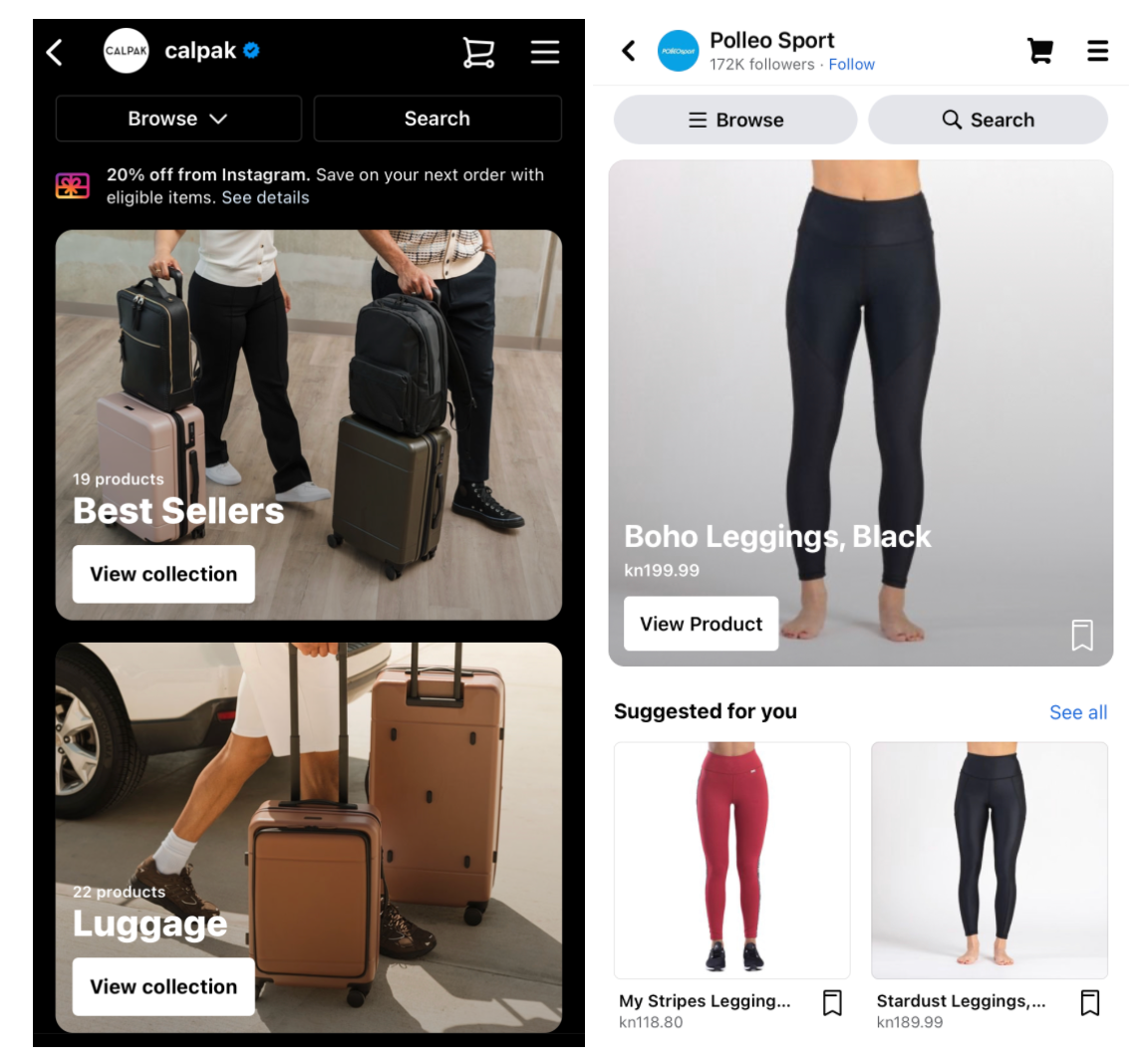
Shoppable organic posts
Let your followers shop directly from your social media posts, like Instagram feed posts (images and videos), Instagram Stories, Instagram Reels, Pinterest pins, Facebook images and carousels, and TikTok videos. These posts look like regular images or videos, with an icon or a label in the corner that indicates there’s one or more products tagged in the post.
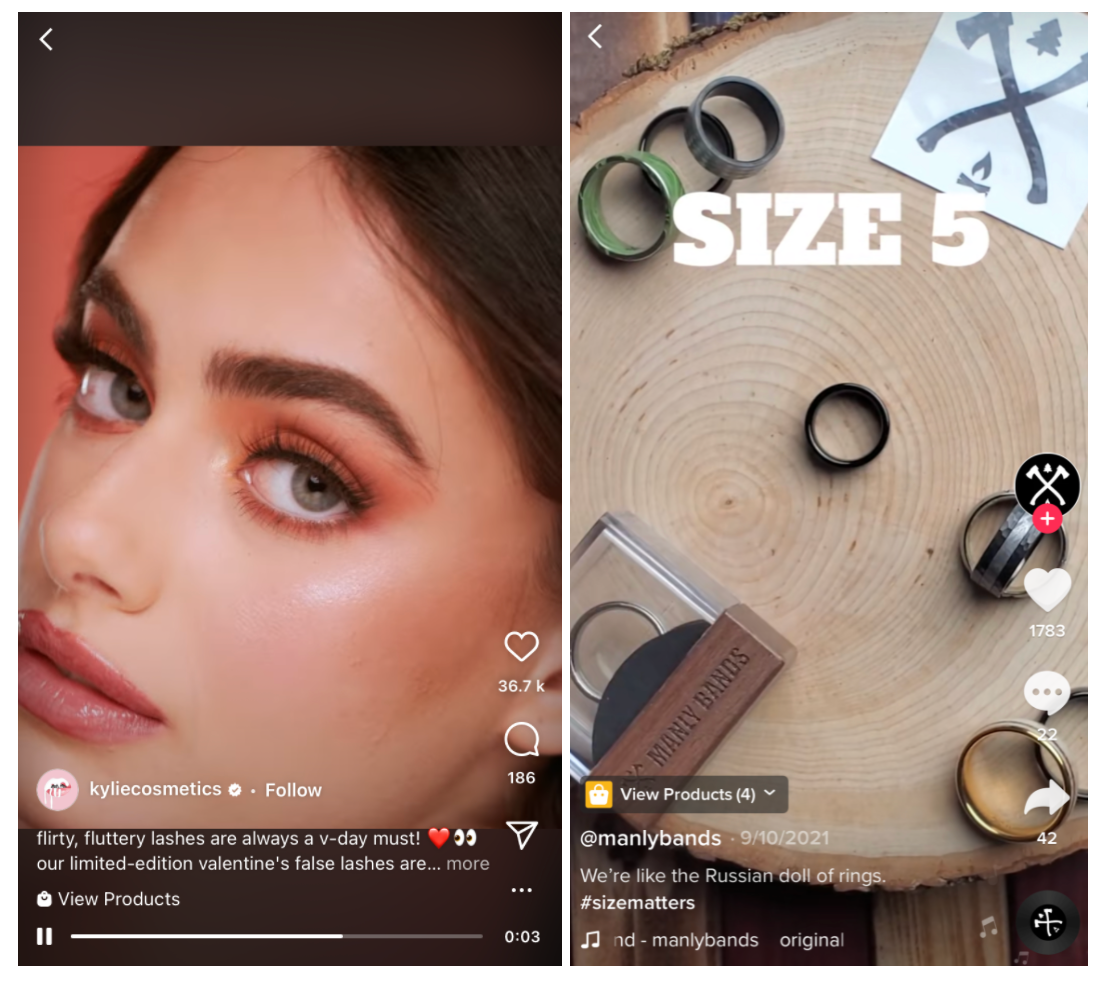
Shoppable paid ads
Brands can choose to serve shoppable posts to a targeted audience by running paid social campaigns. Shoppable ads are often based on the products and categories a user already viewed, so they can serve as a great reminder to continue the purchase.
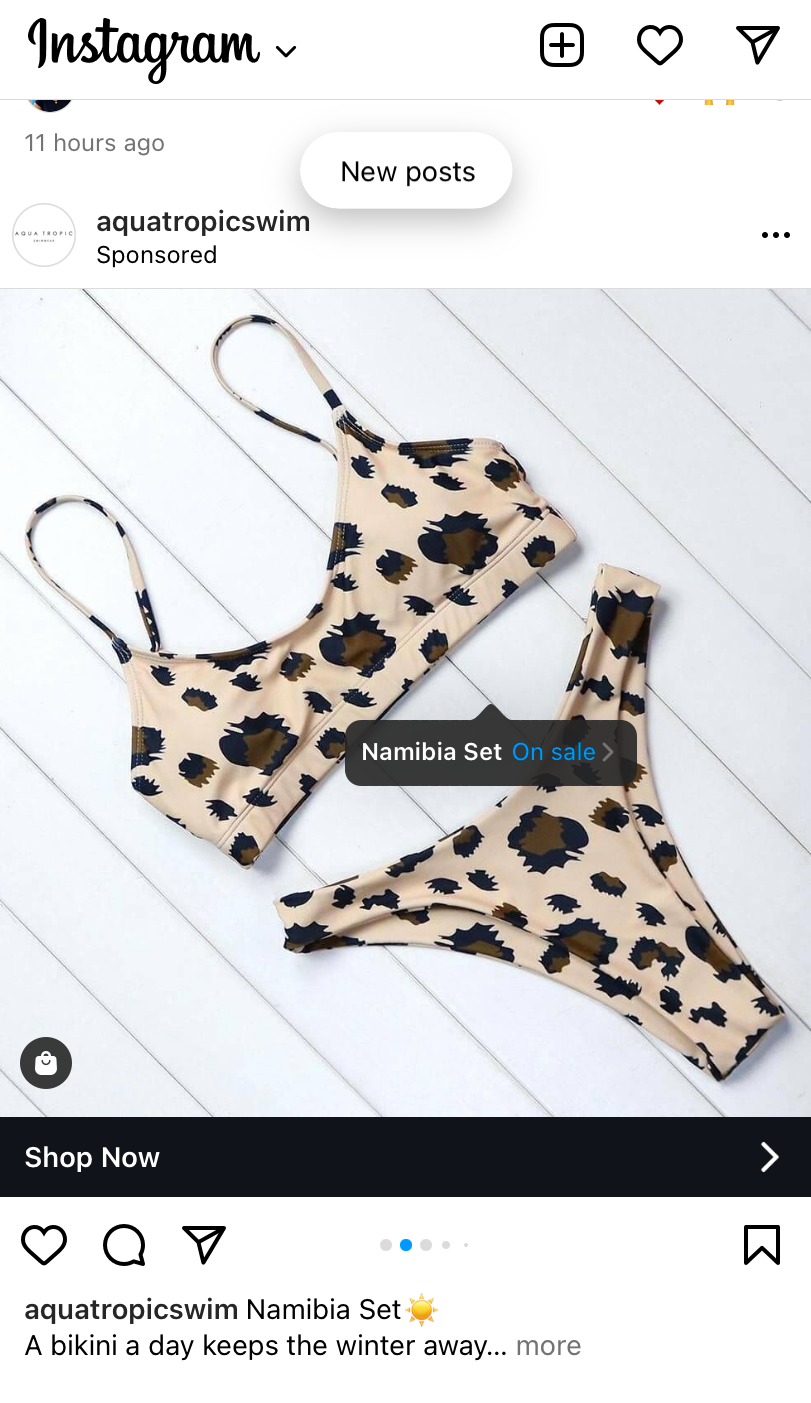
Branded influencer content
Influencers can share shoppable posts, too, by tagging products in their feed posts or Instagram Stories. When a user taps on a product tag, they’re taken directly to the in-app product page on the brand’s profile. In other words, the product isn’t part of the influencer’s profile or shop, but of the brand’s.
This is a great way to create a smooth shopping experience for customers who found you through an influencer.
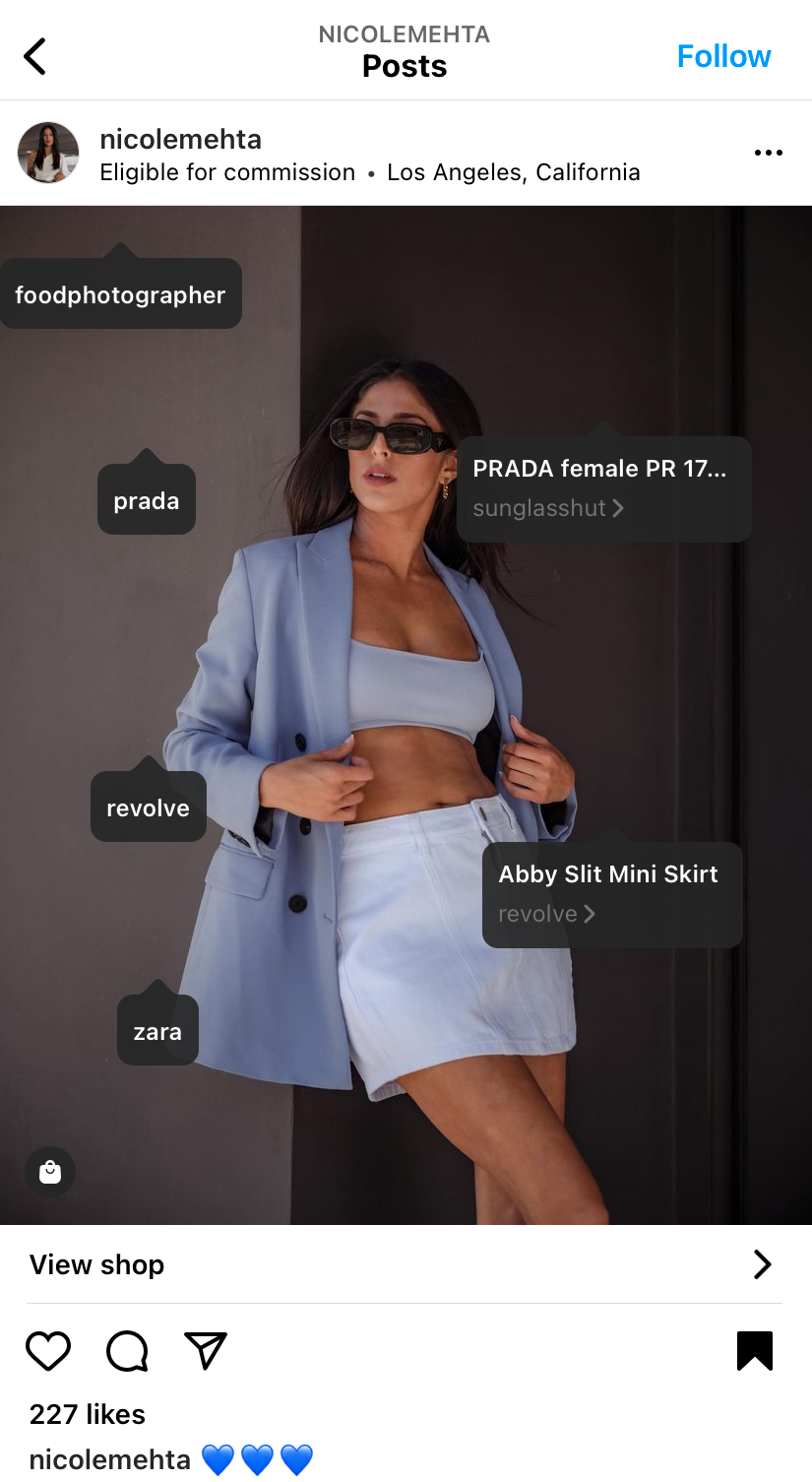
生活购物
生活购物merges live video and ecommerce. With live shopping, brands can create a fun, interactive livestream experience and promote their products, which viewers can then buy directly from the livestream.
生活购物is big in the Asian market, where it reached about$171 billion in 2020. Slowly but surely, live shopping is expanding to the western countries, and it’s predicted to account for as much as 10% to 20% of all ecommerce by 2026. Brands likeAldoandWalmartran live shopping events with success.
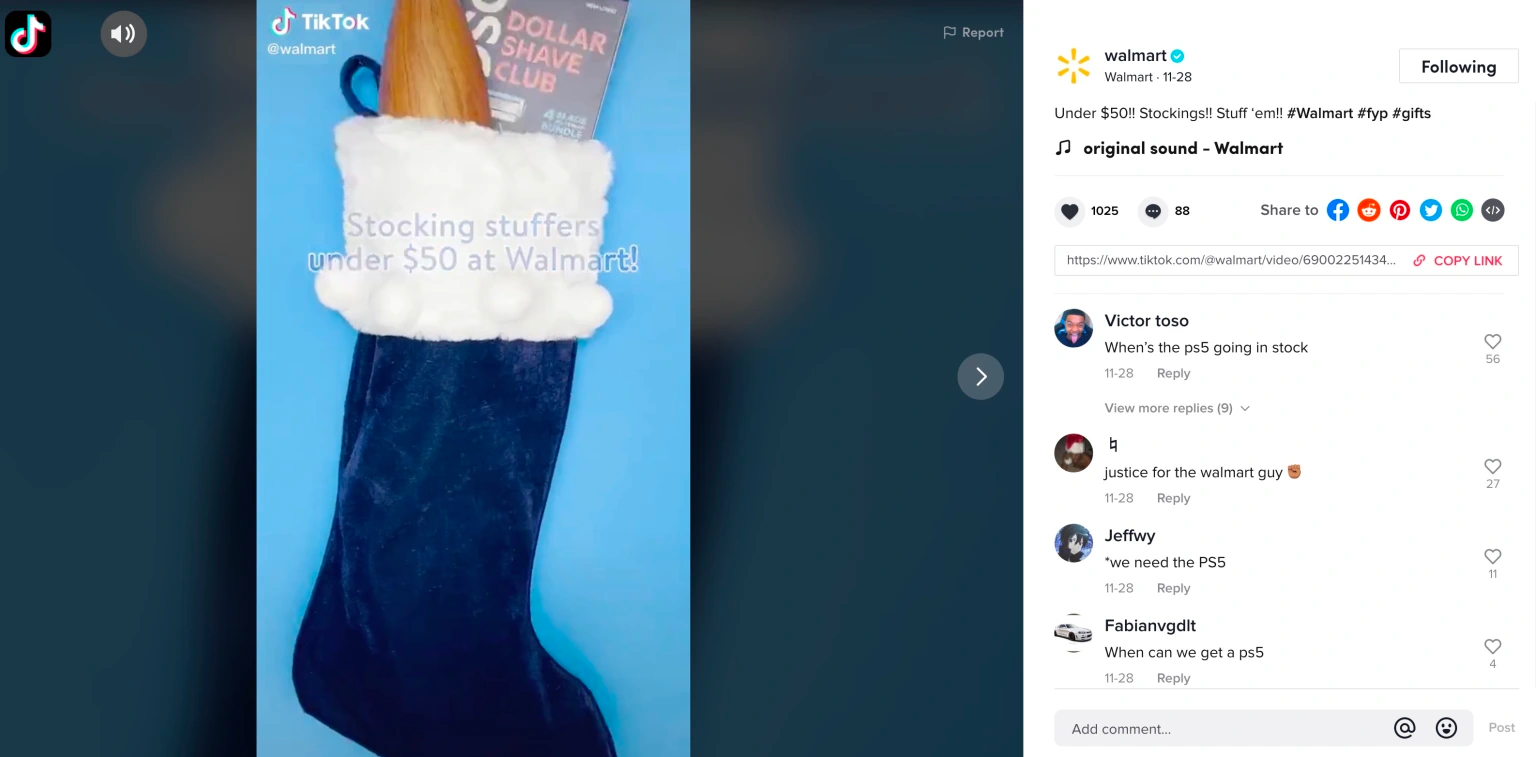
A shop tab or feed
Social media platformslet brands embed their products into their profiles, social media posts, ads, and user-generated content. But some of them, like Instagram, have taken an extra step and dedicated a section of the app to shopping.
定位标签旁边像探索(海rch and recommended content) and Reels. It lists recommended products, promoted stores, wish list products, newly released products from followed accounts, and shops similar to those the user follows and browses. It’s an infinite scrolling experience—it keeps adding posts and products so the user never reaches the bottom of the feed.
Facebook also has a shop tab, but it’s peer-to-peer oriented rather than brands selling to consumers.
Content from social on brands’ social profiles and ecommerce websites
User-generated content(UGC) is a powerful way to merge organic posts by brands’ customers with the capabilities of social platforms.
One way brands do this is by featuring their users’ posts on their social profiles, tagging the user and the products they’re wearing.
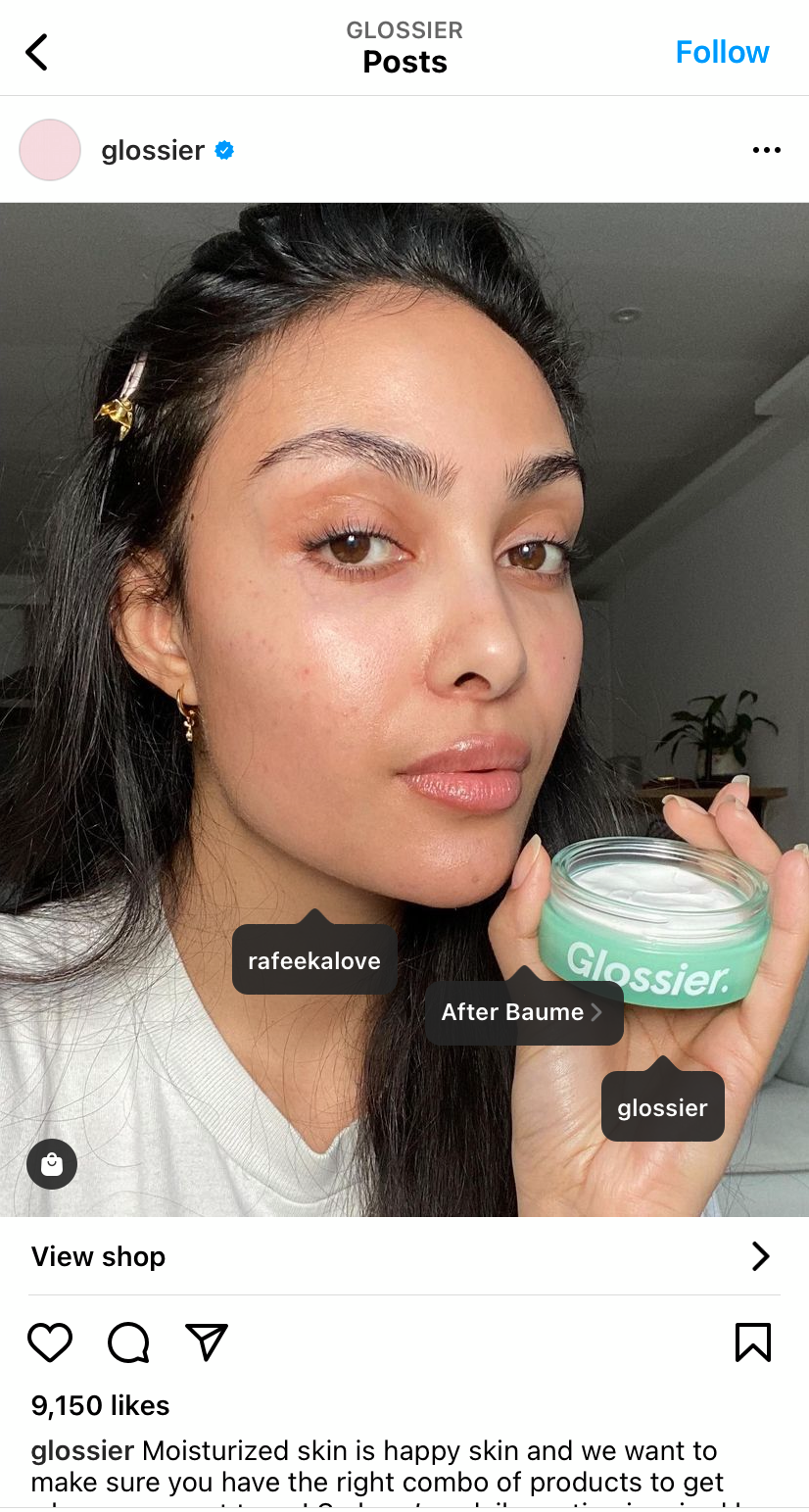
You can also build the user-generated content into the ecommerce site. Brands look for posts that mention their products and embed them into a gallery on their website. They then tag products that visitors can buy directly from those images in the gallery. Great examples come from Skinnydip London’sInstagram gallery pageand Macy’sStyle Crew page
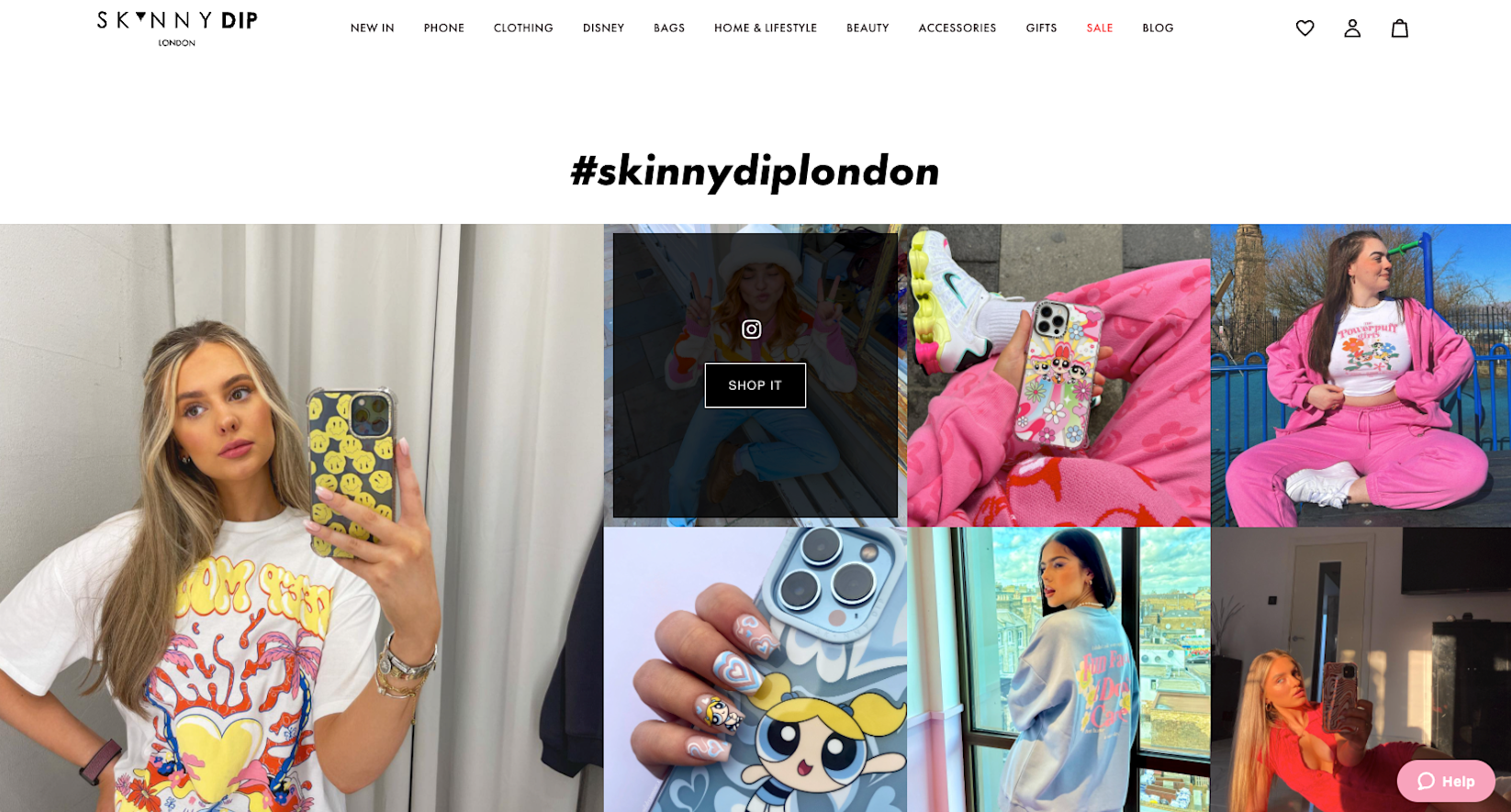
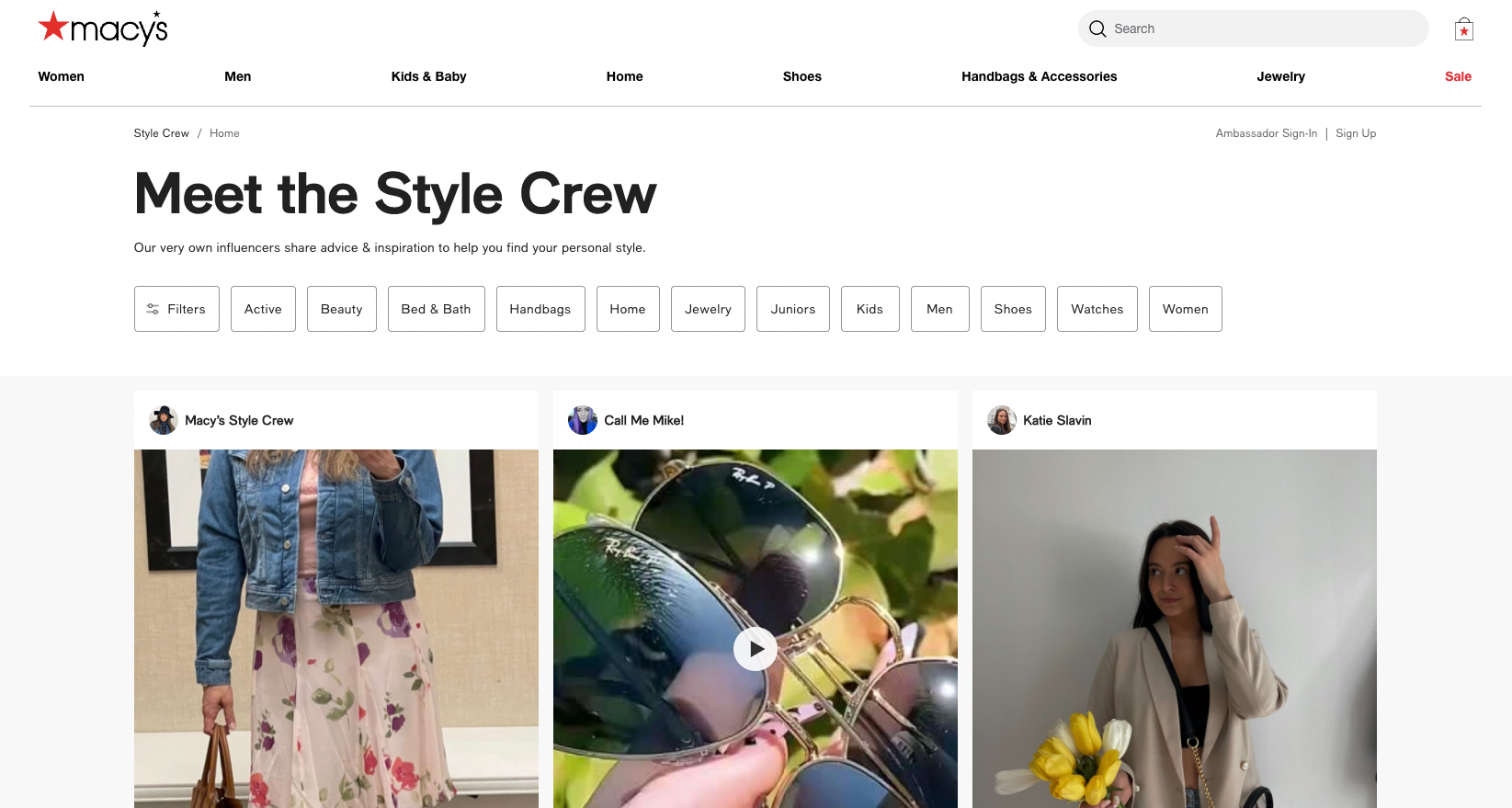
User shopping lists and wish lists
The option to add products to a wish list on ecommerce websites is an important one—it allows customers to create personalized collections of products they like. Now that customers can purchase products through social media, it’s worth letting them create those product collections there as well.
Facebook,Instagram, andPinterestmake it easy for users to save, revisit, and buy the products they like.

Messaging capabilities from in-app product pages
In a physical store, customers can ask store assistants for help. On ecommerce websites, there’s a live chat option that plays the role of that store assistant. On social media, it comes down to DMs—the option to message a brand directly.
The closer the messaging option is to the product or collection page, the smoother the experience will be for the users.
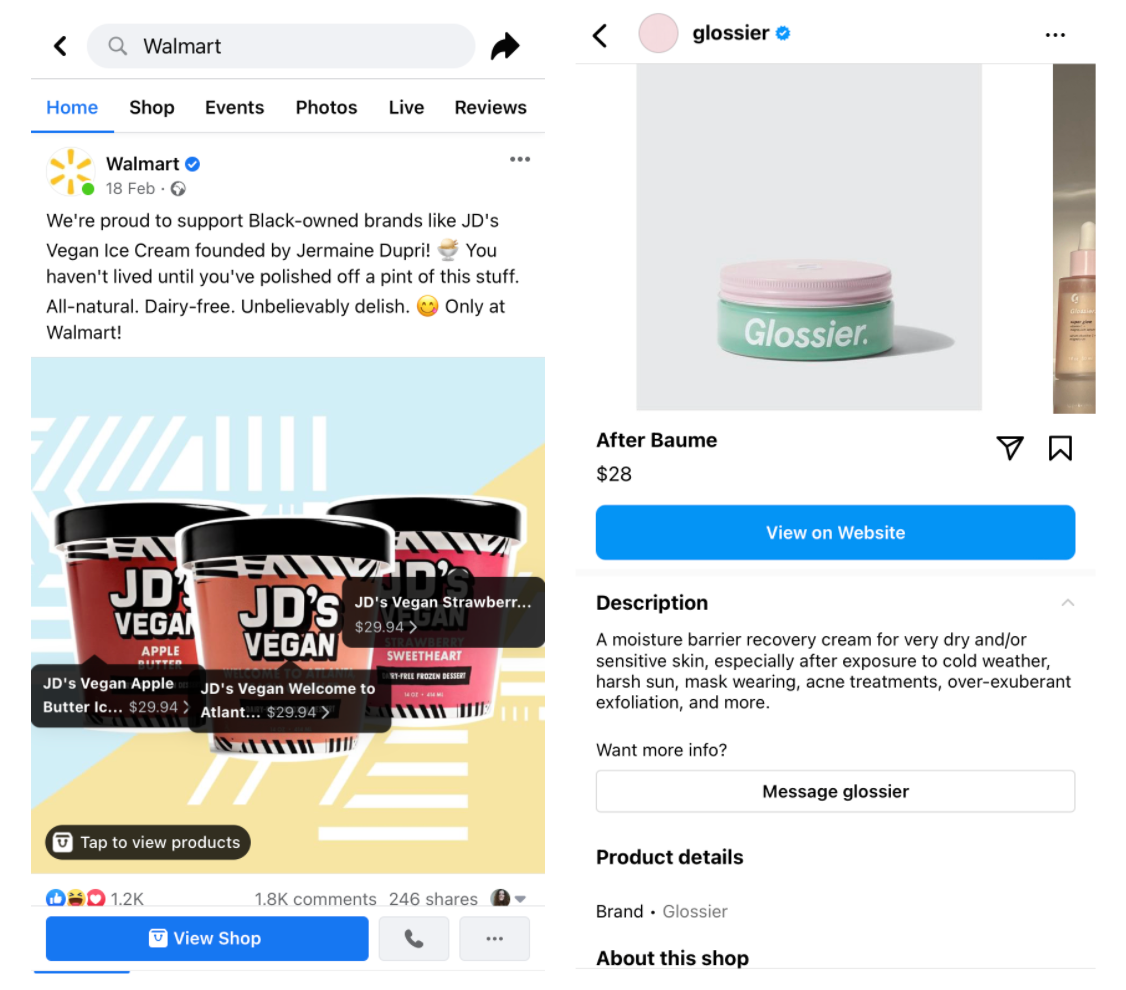
How social media platforms enable social commerce
Let’s run through key features and capabilities of four key places to build a social commerce strategy on: Instagram, Pinterest, Facebook, and TikTok.
Instagram Shoppinglets you take advantage of rich, diverse media formats and options to sell your products through the platform. You can:
- Build a storefront users can tap through from your profile
- Create collections of products based on seasons, types, and other related factors
- Tag products in images, videos, Instagram Stories, Reels, and live video
- Launch ads with product tags
- Enable an in-app checkout experience
- Let customers set reminders for product launches
One of Instagram’s strengths is its ability to mix content formats to maximize their reach and impact. For example, you can share image posts with product tags in Stories or inInstagram Guides. Another example is turning a live video into a long-form video that permanently stays on your profile.
This way, your product-focused content can get more mileage and make sales long after it was posted.
Shopping on Pinterestlets you upload your product catalog. If you want to show different products in different markets, you can upload multiple feeds to the same account.
From there, you can add a Pinterest tag to your website to measure conversions from Pinterest and optimize ads. Ads on Pinterest include shopping ads with product description, pricing, availability, and customer reviews, as well as collection ads with slideshows and videos for richer content.
You can apply for Pinterest’sVerified Merchant Program, which gives you an exclusive Verified Merchant badge, generates a Shop tab on your profile, and shows your products as related pins.
If your store is on Shopify, you canconnect it to Pinterestright within Shopify and automatically add your catalog to Pinterest and set up all the back end you need to sell on the platform.
Once you have a Facebook page, you can create aFacebook shopand add your products to it. Similarly to Instagram, you can direct users to it from the top of your profile with a prominent button.
用户可以通过发现你的店和产品product tags in Stories and ads. In your Facebook shop, they can browse product collections, view product descriptions, save products to their wish list, place an order (in app in the US or on the website), and message you about a specific product.
TikTok
TikTok is the newest social media platform to implement social commerce capabilities for merchants. With TikTok’s integration with Shopify, you can add a Shop tab to your profile and sync it with your product catalog, if you have aTikTok For Businessaccount.
From there, you can tag products in organic TikTok posts, which TikTok viewers can use to shop directly from your storefront. They also can click a tagged product in the video and go to your online store and checkout. Another option is using TikTok to run live shopping campaigns like Walmart in an example mentioned earlier.
TikTok also lets you run ads and target demographics, location, and behaviors as broad or defined as you want. With the TikTok pixel, you can track performance of your ads and find opportunities for even better results.
With more thanone billion usersand35% of thembuying something they’ve seen on the platform, TikTok is the place to explore in your social commerce efforts.
10 social commerce examples to inspire your creativity and strategy
The best way to explore social commerce features and platforms is by diving into examples of companies that make the most of them. Here are 10 examples of social commerce excellence in areas of fashion, beauty, home, and food.
1. 100% PURE
100% PURE, a natural and organic cosmetics retailer, is an international powerhouse. It was launched from a farm in California and built a digital and physical presence in a dozen countries.
The brand maximizes itsPinterest presencewith a storefront packed with categorized products. Tapping on a product leads to product details, a button that takes visitors to 100% PURE’s website, and an option to save the product to a Pinterest shopping list.

最重要的是,100%的纯利用Pinterest ads to show promoted pins to users browsing through other beauty brands and cosmetics-focused pins.
In addition to Pinterest,100% PUREis an Instagram force to be reckoned with. With over 260,000 followers, its photos, Reels, videos, and Guides make it easy for 100% PURE’s followers to discover and buy products while they browse its Instagram feed.
It’s no wonder that Ric Kostick, co-founder of 100% PURE,said to Shopify: “In five years, we believe our ecommerce business will be eight times the size it is today.”
2. Milk Bar
Milk Barstarted as a small bakery in New York City’s East Village in 2008, founded by celebrity chef Christina Tosi. Milk Bar has since grown into a nationwide ecommerce force, selling cakes, cookies, pies, and ice cream.
Before the beginning of the pandemic in 2020,75% of Milk Bar’s revenuecame from its physical stores and the rest came from online sales. The pandemic changed that. Christina leaned on Instagram—and subsequently on its social commerce features—which played a key role in Milk Bar’s success ever since.
Live videos, colorful product images, customer takeovers on Stories, and video tutorials are among the content formats Milk Bar leveraged to get in front of people during initial lockdowns, when they spent more time on social media than ever. With over 800,000 followers today, Milk Bar’s videos often get tens (and sometimes hundreds!) of thousands of views.
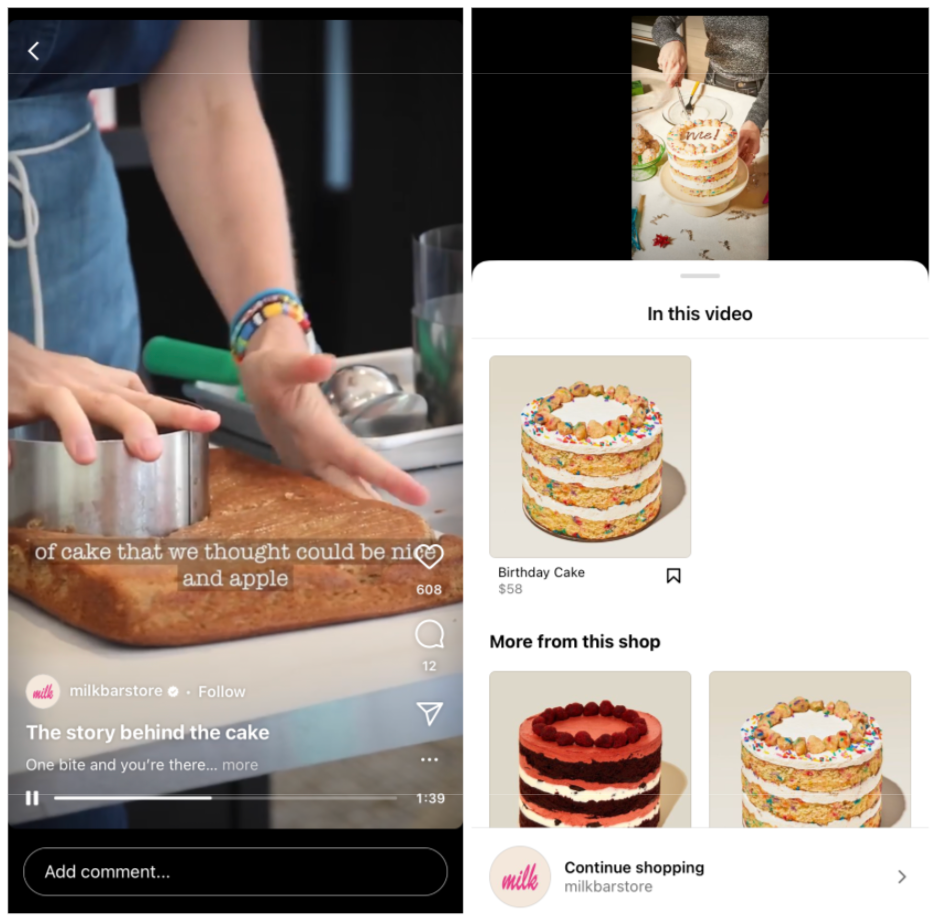
This, of course, is a brilliant opportunity to feature related products from Milk Bar’s Instagram storefront. It’s a perfect combination of inspiration, engagement, and shoppability.
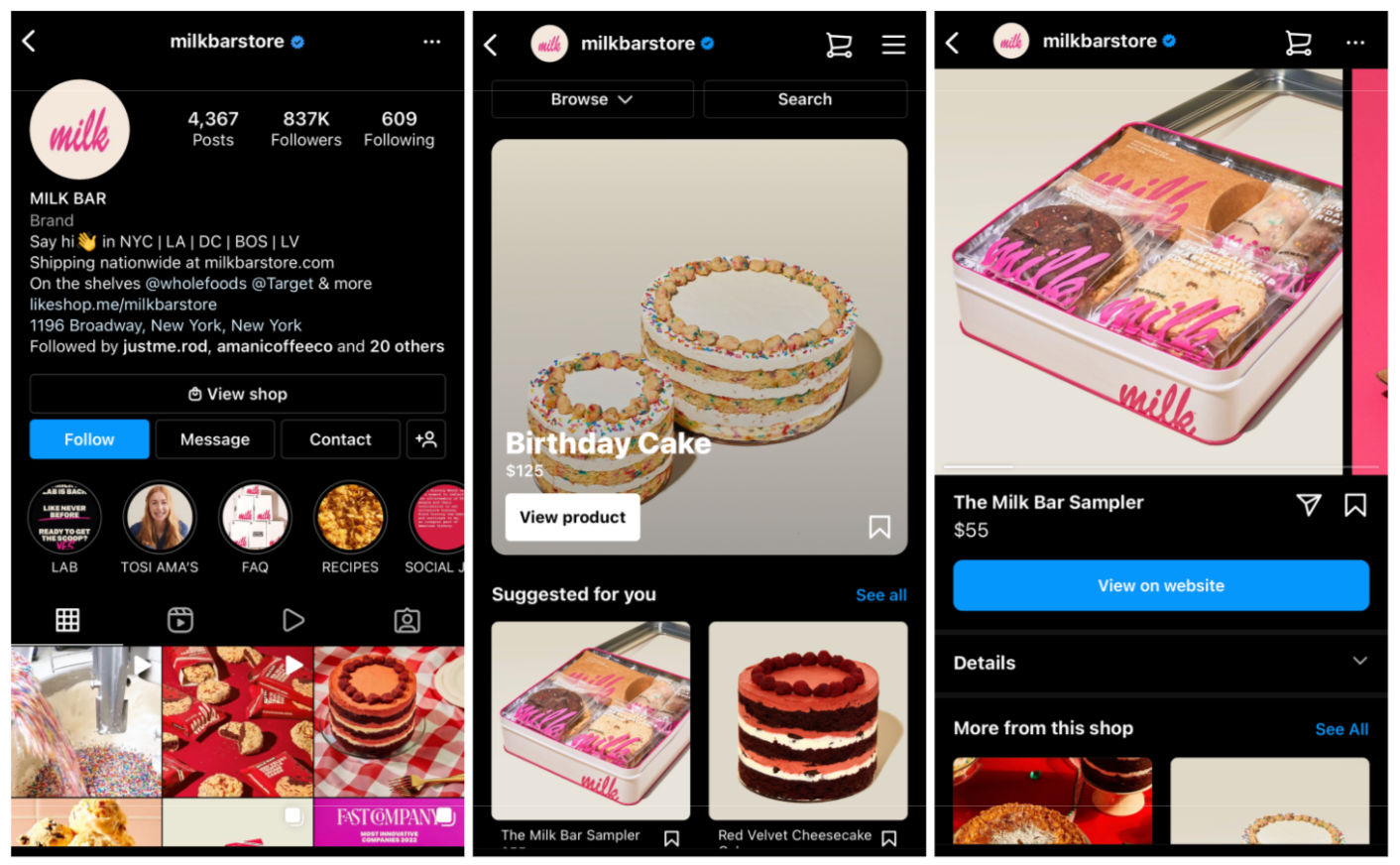
Although it doesn’t use TikTok’s social commerce capabilities yet, Milk Bar packedits TikTok profilewith recipes and baking tips turned into colorful short-form videos. Many of them are sorted into playlists for easy binge-watching—a fun experience for more than 200,000 of Milk Bar’s TikTok followers.
The simple call to action that points to desserts on Milk Bar’s website is a definite plus.
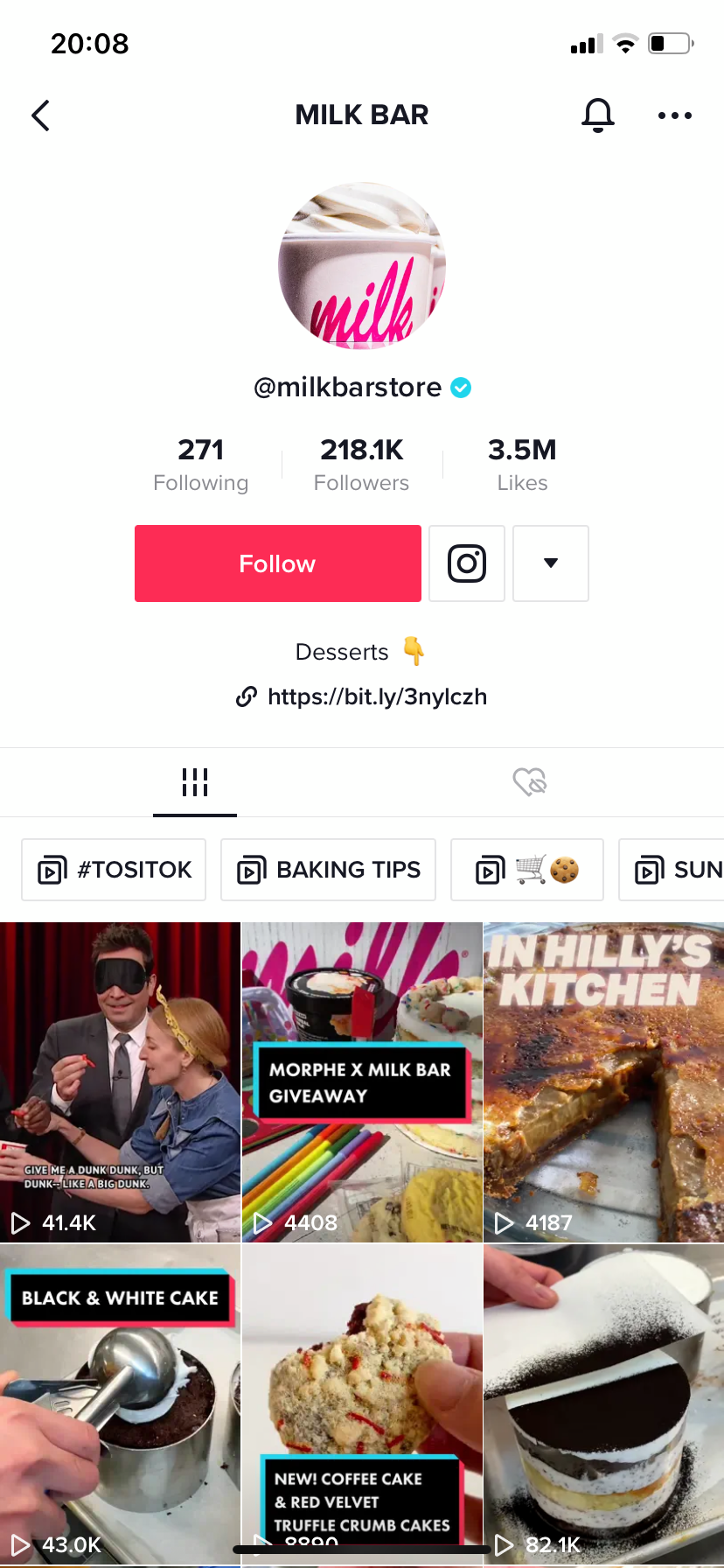
3. JUNO & Co.
JUNO & Co.is a DTC beauty brand that usesTikTokto show how its innovative skin care products work. It’s extremely successful at it: the brand has almost 200,000 TikTok followers and millions of video views on the platform.
After JUNO & Co. joined Shopify’s pilot program for brands to sell their products on TikTok, it saw massive results. “We saw an immediate response. Our sales on TikTok are 10 times what we’ve gained from Instagram and Facebook,” Kyle Jiang, JUNO & CO.’s founder,toldInc.magazine.
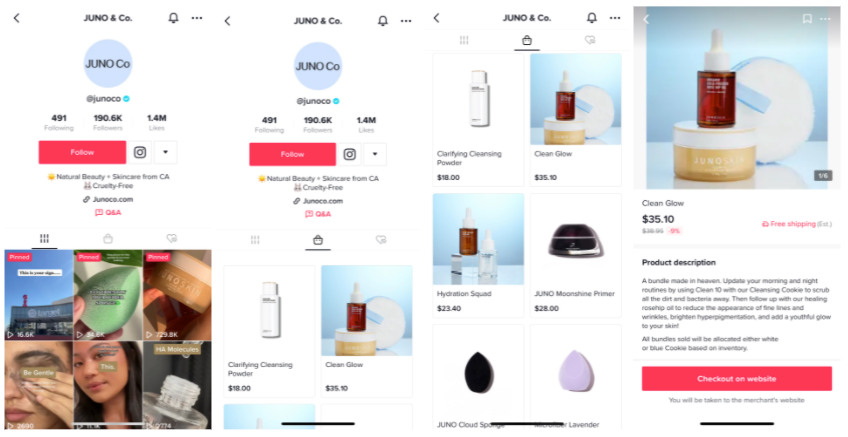
In late 2020,Forbesreportedthat JUNO & Co. grew 300% year over year, with TikTok and Instagram playing a huge role in the company’s success. JUNO & Co.’s engaging videos include product how-tos, giveaway videos, launches, and educational videos.
On Instagram,JUNO & Co.has a slightly lighter, more aesthetic approach. Feed posts are focused on inspiring, visually pleasing images, funny videos, and an occasional cross-posted video from TikTok with no product tags.
游客可以访问朱诺& Co .) Instagram storefront from the main profile and through occasional product tags in Stories.
4. CLUSE
CLUSEis a fashion brand known for its modern watches and jewelry. It was founded in 2009 in the Netherlands and launched aglobal ecommerceoperation in 2014.Instagramwas instrumental in CLUSE’s climb to global success.
CLUSE’s Instagram storefront features hundreds of products. Tapping on a product takes visitors to a product description, an option to message CLUSE with any questions, and a button to view the product on the website and buy it there.

CLUSE’s Instagram feed resembles a fashion magazine, combining closeups of jewelry and watches with photos of people wearing them. Many of the people on the feed are CLUSE customers, ambassadors, and influencers—an approach that played a massive role in CLUSE’s rise to ecommerce success.
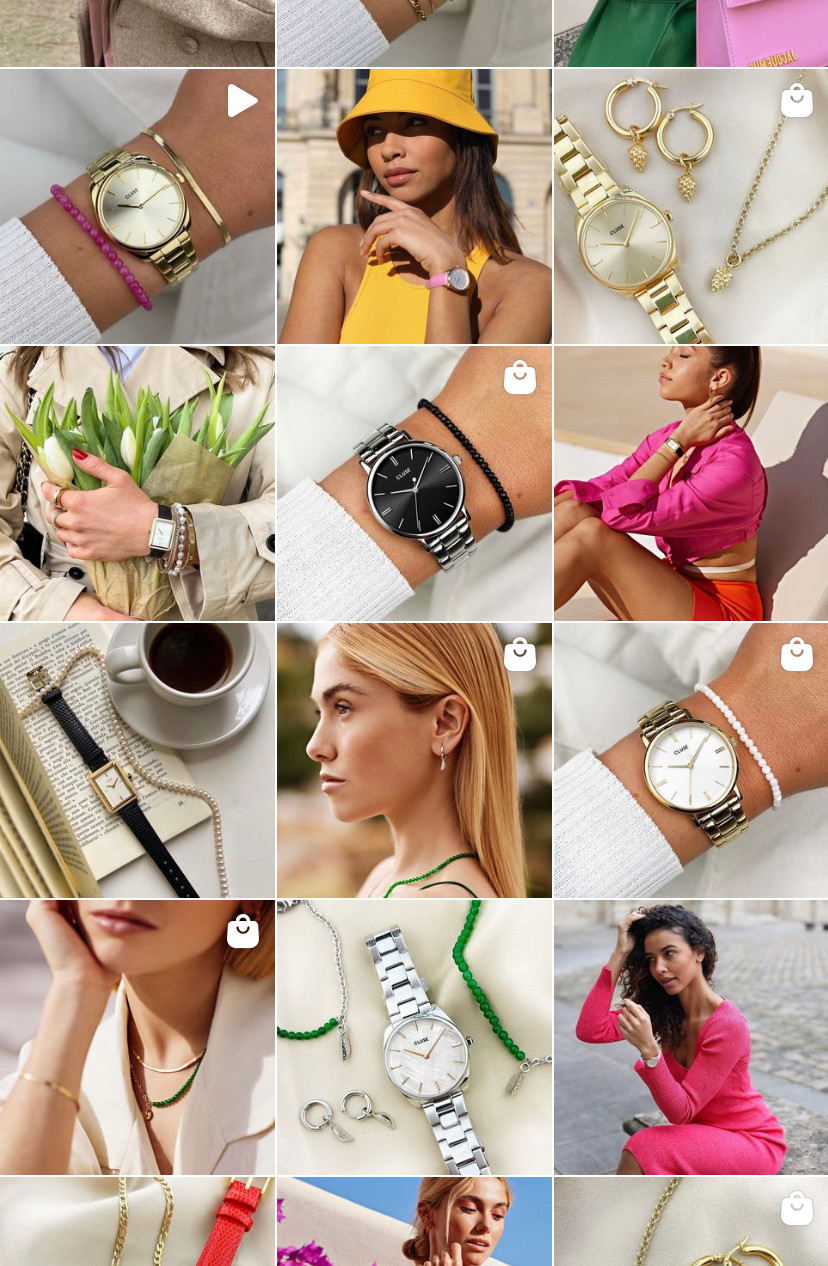
An important page on CLUSE’s website is里, where CLUSE features customer’s images from Instagram and images customers uploaded through the website. Visitors can click on an image they like and purchase products from there.
According toPhotoslurp, this strategy brought CLUSE a 19% overall conversion rate increase.
这就是拉Bekker,横谷的CEO,告诉越南河粉toslurp about CLUSE’s focus on user-generated content: “By using photos made by real customers, our site visitors get a clear and authentic picture of how the watch would look on their wrist, how they can combine the watch with jewelry, apparel, etc. So, from a customer experience point of view, you could argue that it’s actually a no-brainer to make such content available on your website.”
CLUSE brings attention to its ambassadors on a dedicatedambassadors pageon its website and invites people to use hashtags #CLUSE and #CLUSEclub in its Instagram profile, blending the website and Instagram experience together.

5. Glamnetic
Glamneticis a beauty retailer known for its magnetic lashes and press-on nails. It sells through its website and social channels, as well as in stores like Sephora, Ulta, and Nordstrom.
Glamnetic’s strongest social commerce suit is live shopping. The brand regularly runslive videoson Facebook, with product demonstrations and pro tips for its community, with exclusive offers for viewers.
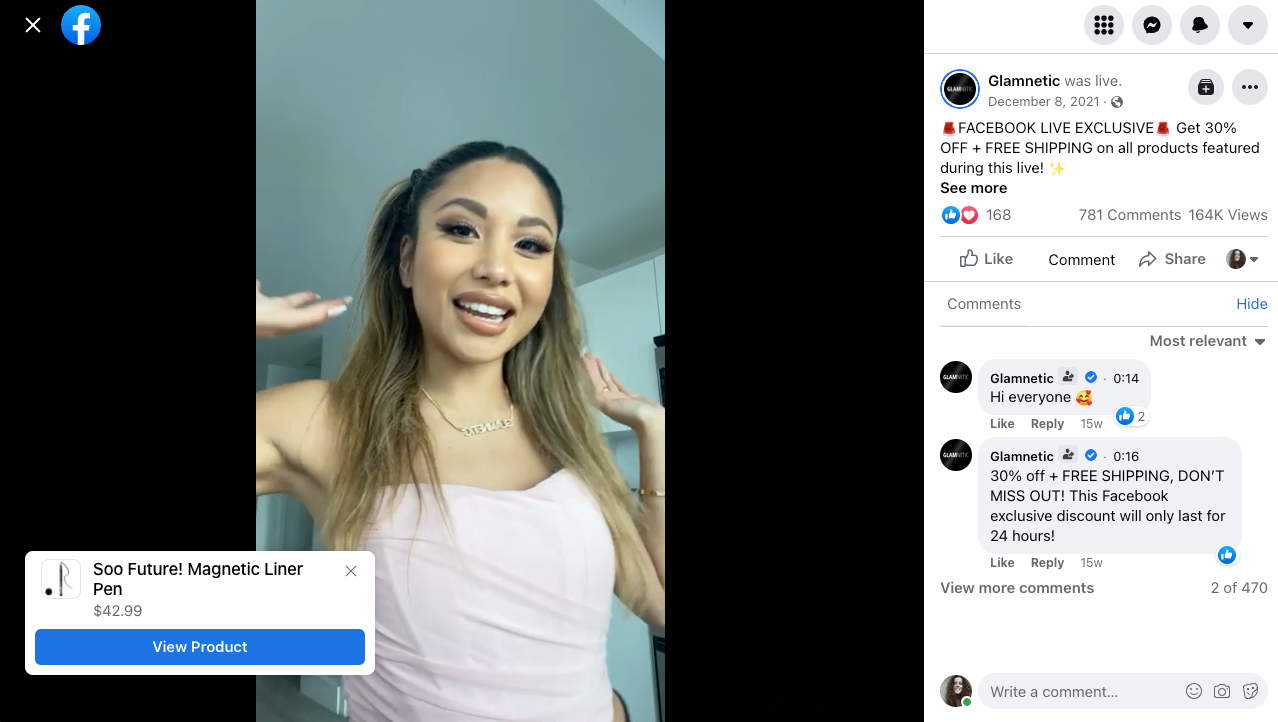
“My prediction is that in a couple years, the hottest role for a brand to hire is going to be a head of live shopping,” Kevin Gould, Glamnetic’s co-founder, said in Shopify’s2022 Future of Commerce report. Glamnetic already employs someone in that role.
Beyond live shopping, Glamnetic takes full advantage of product pages, collections, and tags across all four platforms.

Glamnetic is a Verified Merchanton Pinterest, has a richstorefront on Instagram, and embeds its Instagram posts on its website homepage for a full-circle experience for its customers.
6. Rothy’s
Rothy’sis an eco-friendly fashion brand famous for its washable shoes and bags. The company reported around$140 million in net revenuein 2021, only five years into its journey.
Instagram (300,000+ followers) and Pinterest (10 million+ monthly views) are important factors in the brand’s marketing stack.
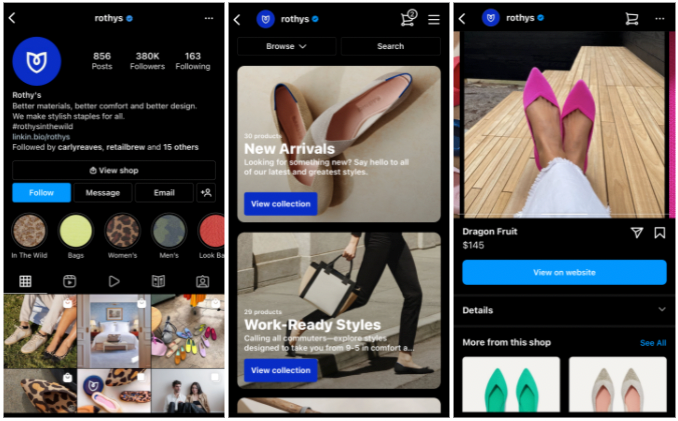
OnInstagram, Rothy侧重于丰富多彩的生活style photos showing what its products look and feel like in everyday life. Majority of the photos have product tags, which takes followers straight to the product page on Instagram.
OnPinterest, Rothy’s visuals are more muted, polished, and editorialized—while still aligning with the brand’s look and feel.
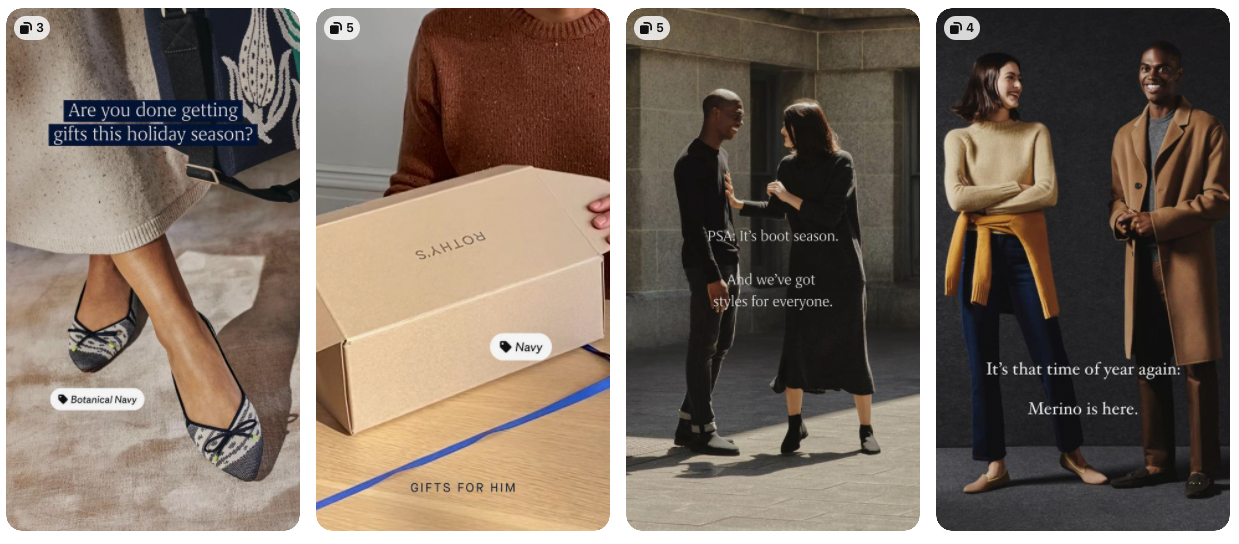
Rothy’s uses Shopify’s integration with Pinterest to sync product details like names, descriptions, color, and inventory levels. This enables them to run Pinterest ads that scale their reach and sales.
Kate Barrows, senior director of growth at Rothy’s,told AdExchanger: “One of the biggest benefits is that Rothy’s data in Pinterest is automatically updated as information changes in Shopify. If a product goes out of stock in Shopify, Pinterest’s feed automatically updates and stops serving ads for that product. Pinterest Shopping campaigns have helped us scale our advertising program efficiently.”
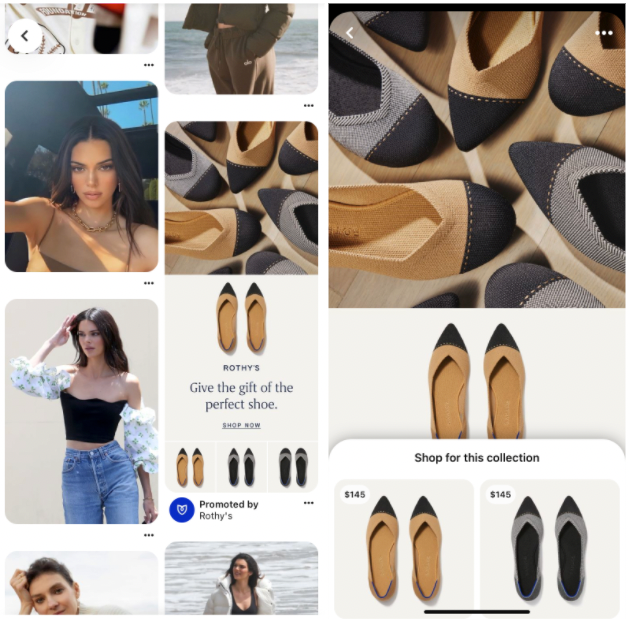
7. Snug
Snugis a London-based sofa-in-a-box company. Snug offers fast delivery and a 100-day trial, and drove much of its £31.6 million (about $41.4 million) 2021 revenue through social media.
Rob Bridgman, Snug’s founder and CEO,told Econsultancythat “people spend more time researching which sofa to buy than which house.” It’s why the brand doubles down on making such a big purchase simple and accessible—and uses social media like Instagram and Pinterest to reach potential buyers looking for inspiration and ideas.
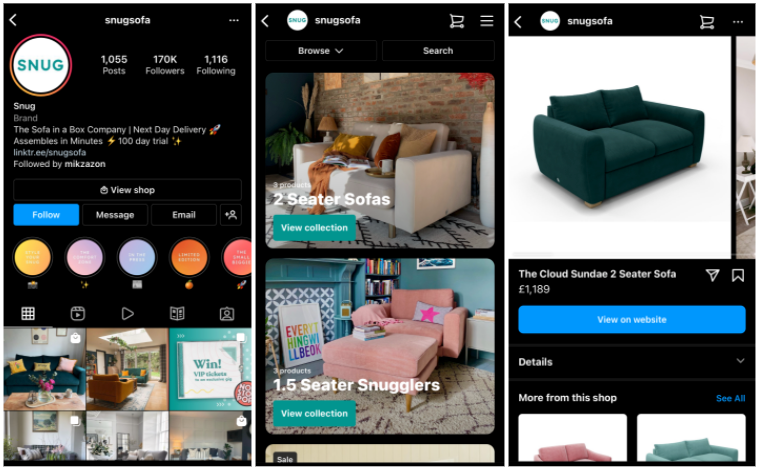
Snug uses live shopping to create buzz around its products. In November 2021, the brand had arecord hour of revenueduring a livesocial sellingevent onInstagramwith comedian Katherine Ryan. This event saw a 450% uplift in sales compared to a similar event in March 2021.
Home décor is a huge category on Pinterest, and Snug built a strongPinterest presenceto take advantage of this. Snug is a Verified Merchant and reaches more than nine million people on Pinterest each month. Its Pinterest boards are categorized by terms Pinterest users often search for, like “sofas for small spaces” and “stylish sofas.”
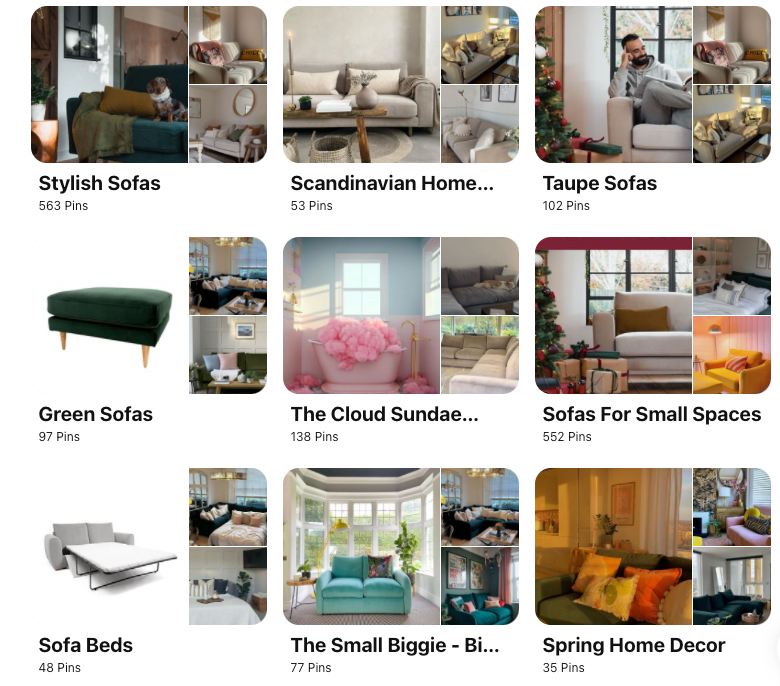
Snug’s product-focused pins showcase sofas in real-life settings, along with product tags and names. Clicking on a product takes pinners to a product pin with a description and a button that leads to the website and easy checkout.
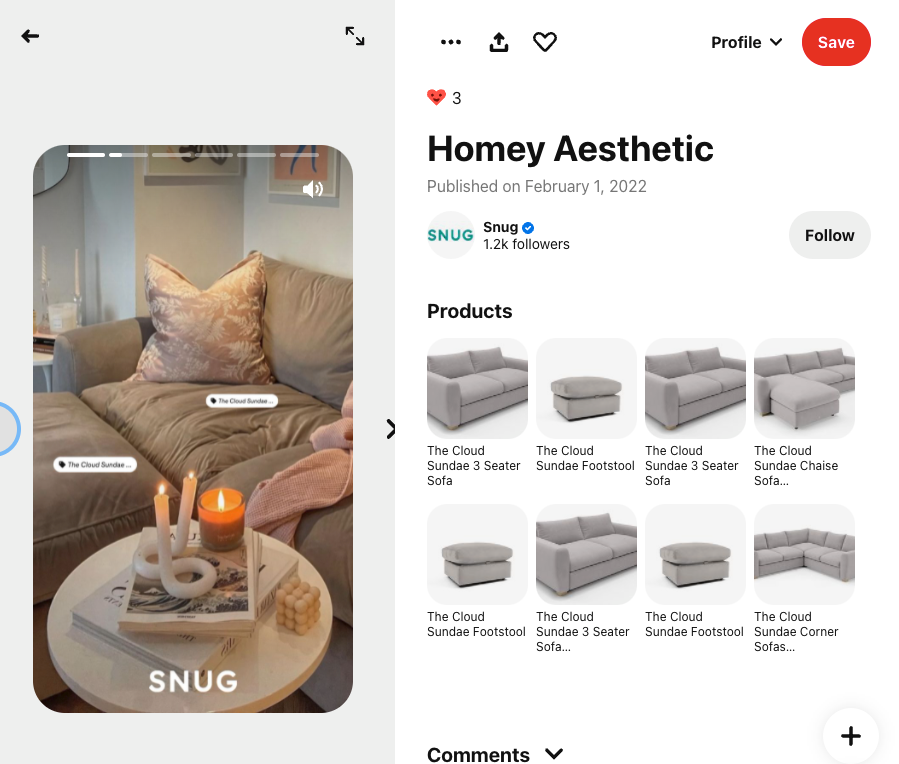
8. CALPAK
CALPAKis a travel brand selling luggage, backpacks, duffels, and accessories. It was founded in 1989 and rebranded its products with a more modern look in 2013.
CALPAK’s brightInstagram feedreaches more than 200,000 followers. It’s no surprise that CALPAK gives these followers an array of options to view products, engage with the brand, and make a purchase.
For example, there are several product-focus highlights with Stories that the brand previously published, including those from customers and influencers.
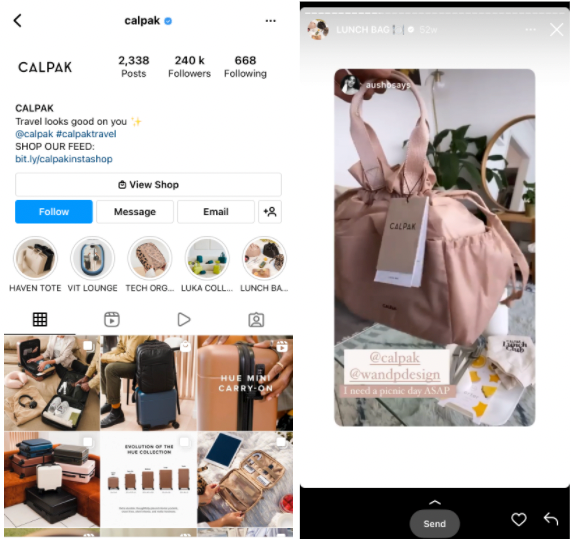
Profile visitors who are ready to purchase a CALPAK product can do so directly from its Instagram storefront through in-app checkout. An alternative option is tapping the link in CALPAK’s profile, right below the Shop Our Feed call to action.

CALPAK’s Instagram Reels are a mix of product teases and how-to videos with product tags for easy access to products, allowing visitors to browse, save, and buy them.
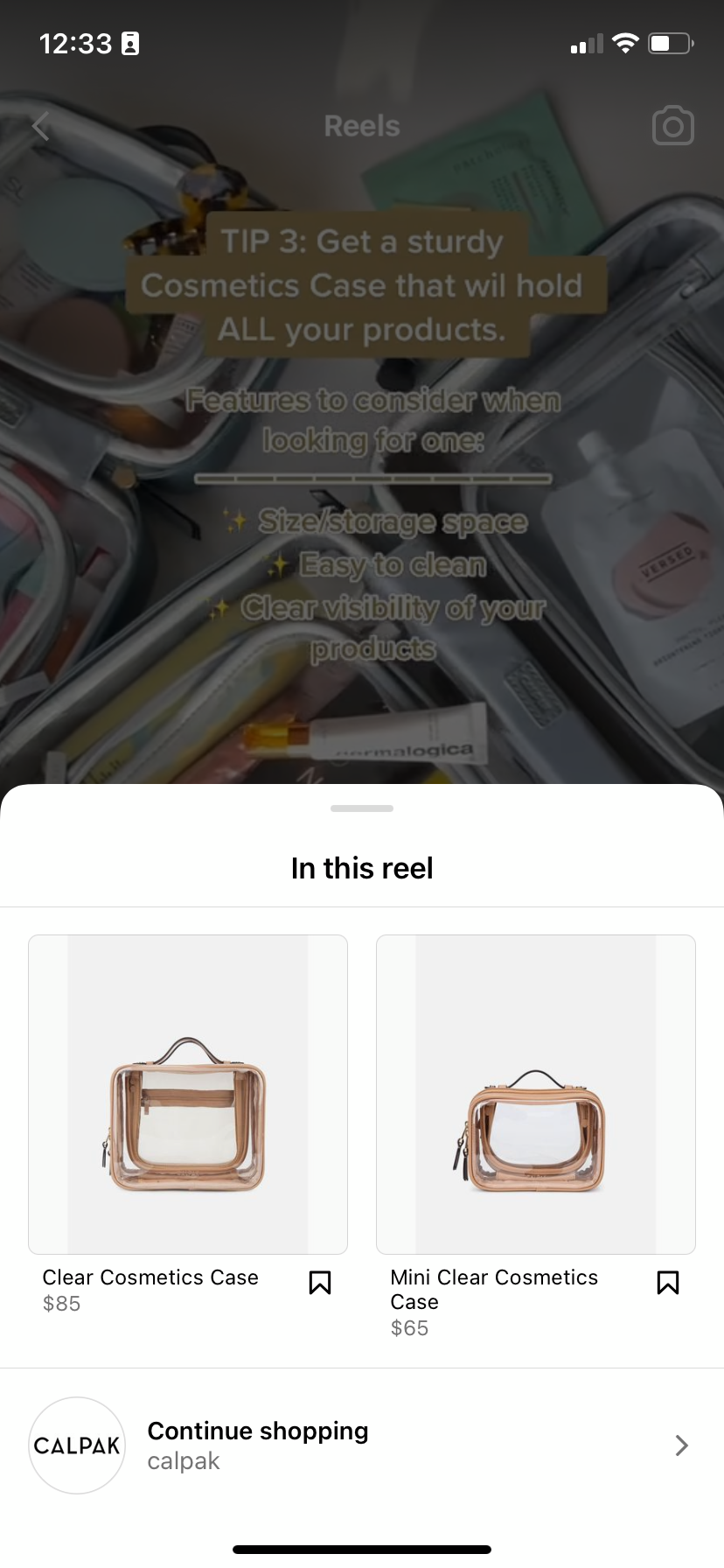
Finally, onPinterest, CALPAK showcases its products in real-life settings, used by happy customers, and organizes them by specific products.
9. Kylie Cosmetics
Kylie Cosmeticsis a clean, vegan makeup and beauty brand by Kylie Jenner. Kylie Cosmetics launched its first products in 2015 and helped turn Kylie Jennerinto a billionaire by 2019.
The social media reach of Kylie Cosmetics is a definite outlier on this list, but it’s worth looking into and learning from.
Kylie Cosmetics makes the most ofInstagram’scommerce capabilities, with over 150 products and detailed descriptions. To showcase and promote those products, the brand partners with numerous influencers and tags the products in images and Reels.
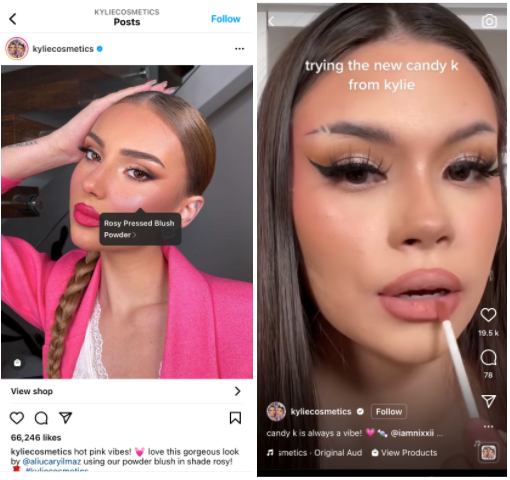
Kylie Cosmetics is also an integral part of TikTok Shopping. When Shopifyannounced its partnership with TikTokto bring ecommerce features to the app, Kylie Jenner said: “I built my business on social media; it’s where my fans go first to look for what’s new from Kylie Cosmetics. I have so much fun creating TikTok videos, and I love sharing posts of my fans using the products. That’s why I’m excited for Kylie Cosmetics to be one of the first to let customers shop directly on our TikTok!”
Kylie Cosmetics can tag its product inTikTok videosand send viewers to an in-app product page, which can then lead them to the website to make a purchase.
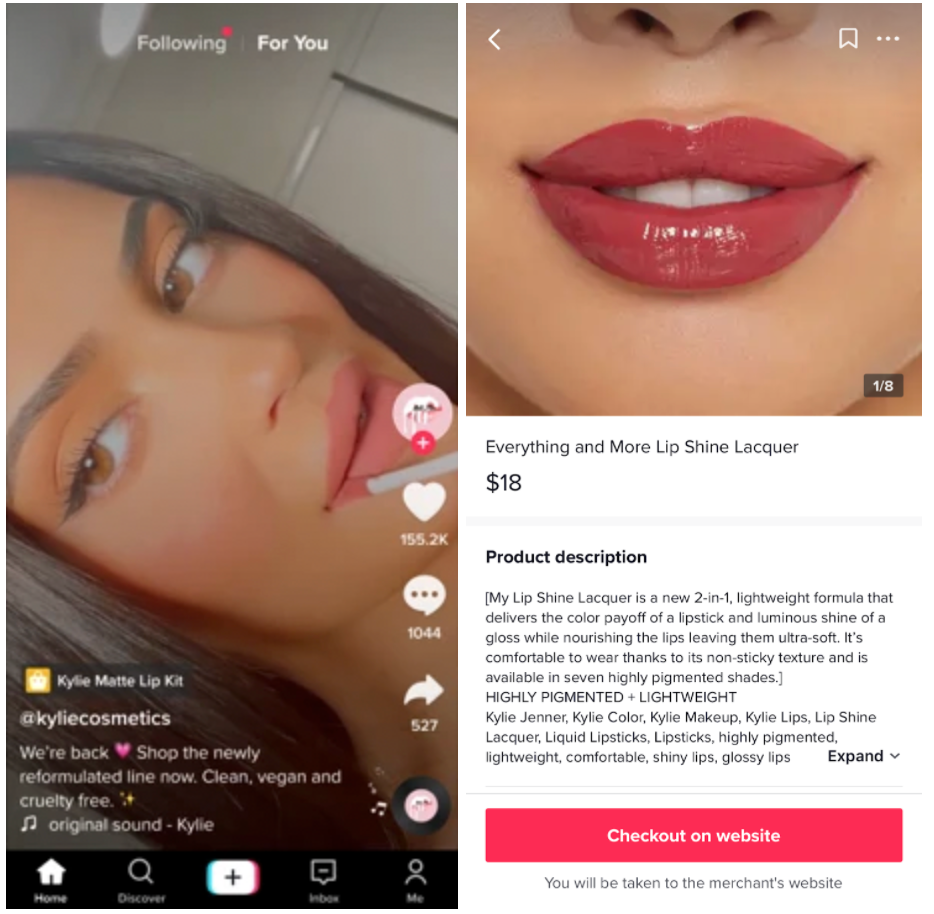
10. ZOX
ZOXis a DTC wristband brand. ZOX wristbands are made of recycled bottles and, thanks to inspiring messages on them, serve as wearable reminders of positivity to those wearing them.
ZOX has built a storefront onFacebook, where it invests lots of effort into live shopping events and lists over a hundred products customers can browse and learn more about.
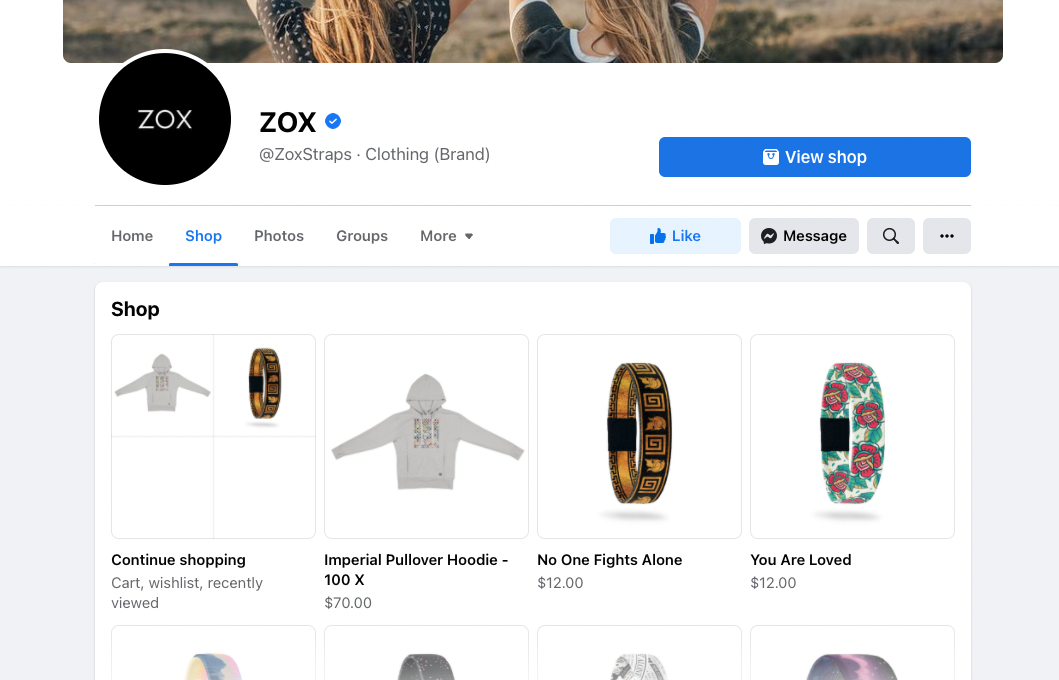
The focus on Facebook has come from ZOX’s roots on social media.In a podcast interviewon My Total Retail podcast, ZOX’s CEO and cofounder, Jason Kuipers, said: “ZOX was really born on Facebook. Our very first VIP group that we had was started in 2012, and all the way back there is where we were listening to customers about things that they thought were important.”
Without a physical store, ZOX looks for ways to connect with its customers on a more personal level, and Facebook has made that possible. Beyond theZOX VIPgroup that counts more than 30,000 members and sees dozens of posts each day, ZOX leverages Facebook for live shopping events.

In the same podcast interview, Jason explained what makes live shopping so valuable to ZOX: “Consumers nowadays have more options than ever before of where to spend their money, and if you aren’t doing something that allows you to meet them exactly where they are, you’re missing out.
“Live shopping is incredibly valuable for us because we don’t have a physical retail store, and if you came to our site, looked around, and then didn’t buy anything, I don't get to talk to you. I don't get to ask you what you’re looking for. So live shopping means we’re able to treat customers very similarly to that retail experience where people get to actually come in, watch the lives, get to hang out with me, and ask questions.”
ZOX also has a large community onInstagram, where visitors can make purchases using in-app checkout. ZOX’s Instagram content resembles its posts from Facebook, with an important addition: many of its Instagram Stories are solely focused on resharing posts and Stories from its customers wearing ZOX wristbands. These Stories are then stored in several Story highlights titled ZOX FAM.
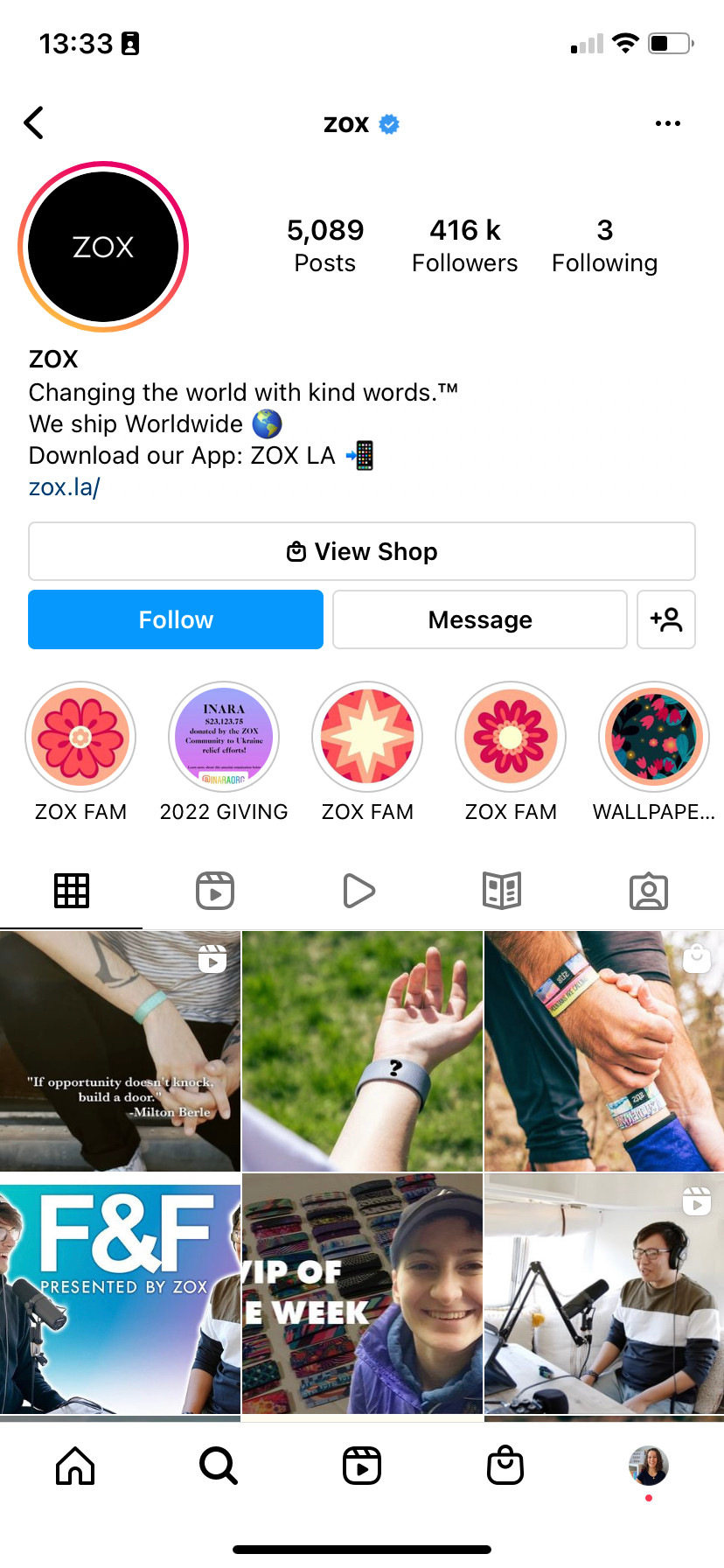
How Shopify can power up your social commerce
Social commerce can bring your community, customer loyalty, sales, revenue, and brand awareness to the next level. Just like for many of the brands we covered, it can be the foundation for explosive growth.
When it comes to executing a social commerce strategy, Shopify merchants have an advantage. On Shopify, you can create, run, and optimize social campaigns on Instagram, Facebook, and TikTok from within your admin and turn them into your shop’ssales channels. For example, Shopify makes it easy to create product links, in-feed ads, and a shopping tab toob3体育 .
The result? A seamless shopping experience your customers will want again and again.






